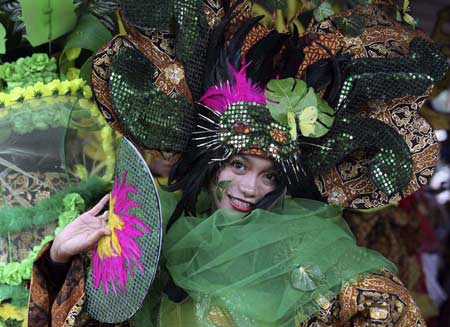Seven young people from Bandung, West Java, grouped together as the Bluemoon Technology-Pixel People Project have introduced a potentially revolutionary innovation to the world of batik design in Indonesia with the launch of their Batik Fraktal V2 software, which enables batik to be designed without human intuition.
The software, development of which began in late 2007 with the support of the Agency for the Assessment and Application of Technology, the Research and Technology Ministry and a grant from Senada-USAID, enables designs to be made by a computer, which processes traditional batik design patterns into millions of new motifs by using fractal mathematics formulas.
The software launching ceremony was held at the Blitz Megaplex in Bandung recently and was attended by Research and Technology Minister Kusmayanto Kadiman, head of the West Java Industry and Trade Office Agustiar and representatives from Senada-USAID.
Nancy Margried, who served as project manager for the Pixel People Project, said the software allows traditional batik makers to design an unlimited number of motifs. She added the basic forms in the software, such as angles, length and repetitive motifs, were taken from traditional batik motifs, such as from Pekalongan, Garut, Yogyakarta and Surakarta.
"We have included a number of basic motifs, such as angles, length and motif duplication in the database so as to facilitate making batik motifs," Margried said.
Minister Kusmayanto said his ministry had provided support to the Batik Fraktal software given its extraordinary innovation, which combines art, computer, mathematics and economics.
"I am impressed because the innovation could expand batik sales extensively. Batik, which was regarded as traditional and out-moded, can now become a trend among the younger generation with its new and up-to-date designs," Kusmayanto said.
Nancy said batik fabrics could be made manually by using the traditional manner and the computer designs could easily be downloaded to the batik printing machines for mass production. Besides government agencies, Nancy said demand for the Batik Fraktal software was also sought after by customers from Australia, the United States and Singapore.
"We sell it in the form of software, design and finished products, but our capital is still limited so we have to bring in new investors."
They have decided to provide the software free to traditional and small-scale batik makers, but have set a high price for large-scale companies and overseas orders so as to protect local batik makers.
In Cirebon, traditional batik makers have aired their concern over the influx of Chinese-made batik products flooding the domestic market, including those producing the local Cirebon batik, better known as Trusmi.
They are afraid the Chinese-made batik could wipe out the local batik industry, which is managed traditionally.
The batik makers have urged the government to act immediately to anticipate the problem and take serious moves to protect the traditional batik industry, which is part of the national cultural wealth.
"The government should act quickly to prevent the invasion of Chinese-made batik," Katura, an elder member of the Trusmi Traditional Batik Artisans Association, said.
from: jakartapos






























